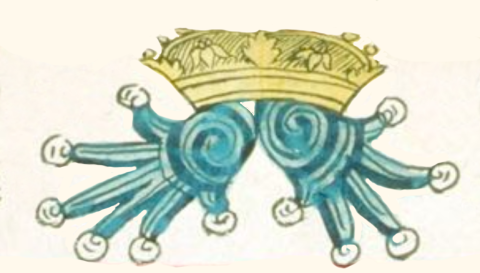Almoyahuacan (Chav8)
This detail from a multicolored painting shows the compound glyph for the place name, Almoyahuacan (perhaps "Where They Have Turbulent Waters"). The glyph has a golden crown at the top, which may be a reference to the altepetl. Below the crown are two swirling sprays of water (atl), and their motion may represent the verb moyahua, to disturb clear water. The dual sprays of water have a swirl at the start, with thick and think lines of current, and one has five little streams with the same lines and droplets at their tips. The other has six little streams coming off the swirl. The -can locative suffix may be implied by the regal crown, which may be a statement about the town, Santa María Asunción Almoyahuacan.
Stephanie Wood
At the time of the composition of this manuscript, the Matrícula de Huexotzinco, this town was one of the four altepetl that were deemed cabeceras of Huejotzingo (in the contemporary spelling) by the colonizers. [See: F. G. Hoekstra, "Two Worlds Merging: The Transformation of Society in the Valley of Puebla, 1570–1640," Ph.D. Dissertation, 1993, 29.} See below for two other examples of Spanish-style crowns and two examples of indigenous diadems.
Stephanie Wood
Barrio De Sta. Maria Asuncion
al.moYahuacan :~
Barrio de Santa María Asunción Almoyahuacan
Stephanie Wood
1578
nombres de lugares

moyahua, to disturb clear water, https://nahuatl.wired-humanities.org/content/moyahua-2
atl, water, https://nahuatl.wired-humanities.org/content/atl
hua, singular possessor suffix, https://nahuatl.wired-humanities.org/content/hua
-can, place of, https://nahuatl.wired-humanities.org/content/can-2
aletepe(tl), town, pueblo, https://nahuatl.wired-humanities.org/content/altepetl
cabecera, a head town of a district (a loan from Spanish that entered Nahuatl), https://nahuatl.wired-humanities.org/content/cabecera
The Codex Chavero of Huexotzinco (or Códice Chavero de Huexotzinco), https://www.loc.gov/resource/gdcwdl.wdl_03246_001/?sp=1
The Codex Chavero of Huexotzinco (or Códice Chavero de Huexotzinco) is held by the Instituto Nacional de Antropología e Historia, México. It is published online by the World Digital Library and the Library of Congress, which is “unaware of any copyright or other restrictions in the World Digital Library Collection.”



